Miboxer C2 6000
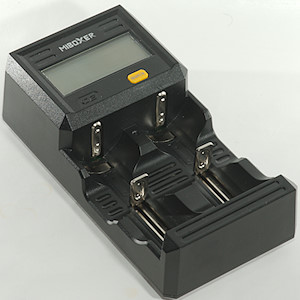
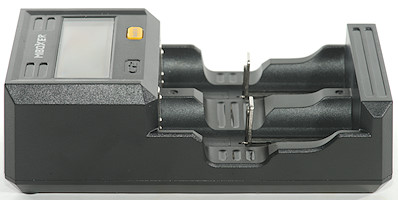
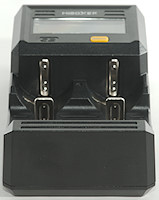
Miboxer is expanding their line of chargers, this time with a charger that can handle large batteries and high charge current.
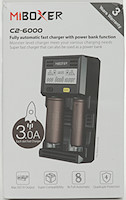
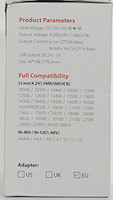
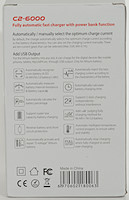
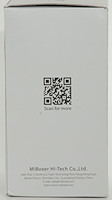
The charger comes in a retail box. There is some specification on the box.

The pack contained the charger, a power supply and an instruction sheet.
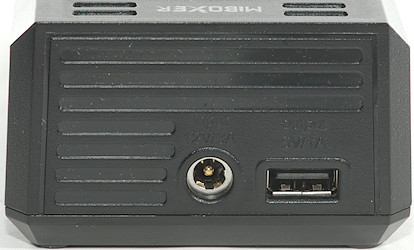
The power input is a 12V barrel connector. There is also a usb output.
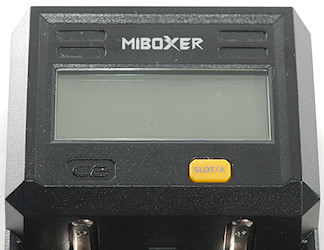
The charger will usual select charge current based on internal resistance and chemistry based on voltage (Only LiIon 4.2V and NiMH). With the button it is possible to override the current selection.
A fast press on the button will select slot, holding down the button will enable manual current selection. When in current selection each press will step to the next current.
For LiIon the currents are: 0.10, 0.20, 0.30, 0.50, 0.80, 1.00, 1.50, 2.00, 2.50, 3.00
For NiMH the currents are: 0.10, 0.20, 0.30, 0.40, 0.50, 0.60, 0.70, 0.80, 0.90, 1.00
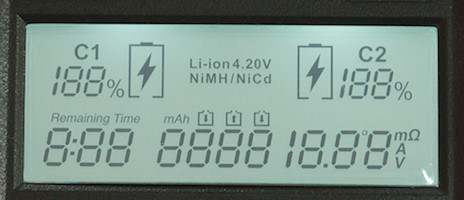
Here are all the segments in the display.
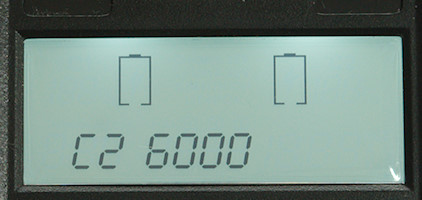
When the charger is idle it shows the model number.
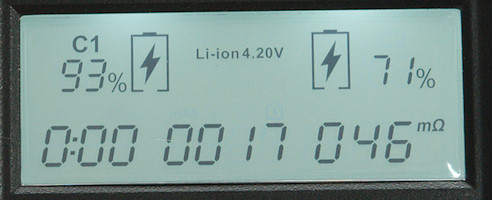
An example of the readout. The charger can display: Estimated charge time, used time, current, voltage, internal resistance, temperature and mAh
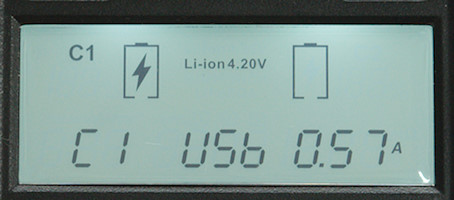
When using usb output it will show how much current is drawn on the usb connector. This will, of course, use some of the power from the battery.
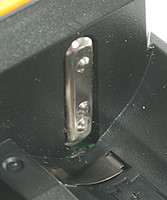
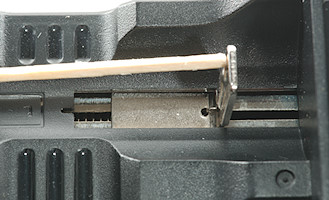
The battery slot is the typical slider construction, but are made to work with both small and large round cells. The slot accepts from 33mm to 72mm long cell and up to 32mm diameter, both LiIon and NiMH.
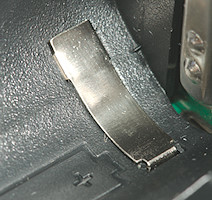
Each battery slot also has a temperature sensor.
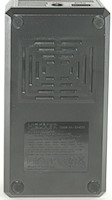


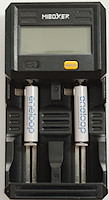
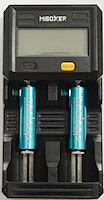

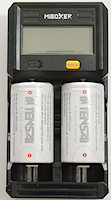
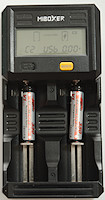

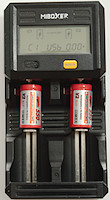
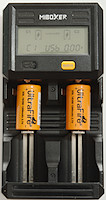
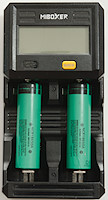
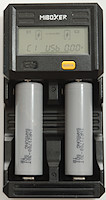

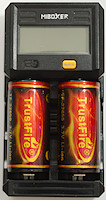
The current may be too high for some cells on automatic and requires manual override.
Measurements
- Power consumption when idle is 0.2 watt from mains.
- Will discharger a LiIon battery with about 0.2mA when not powered.
- An empty LiIon battery will be discharged with about 3mA (bad)
- Will discharger a NiMH battery with about 0.4mA when not powered.
- Assumes NiMH below 1.9 volt and LiIon above.
- Voltmeter is within 0.01 volt
- Voltmeter will not drop below 4.20V when LiIon battery is full.
- Charging will not resume if voltage drops.
- It will restart charging on reinsertion of the battery or power cycling.
Charging 4.2V LiIon
Currents: Auto, 0.10, 0.20, 0.30, 0.50, 0.80, 1.00, 1.50, 2.00, 2.50, 3.00
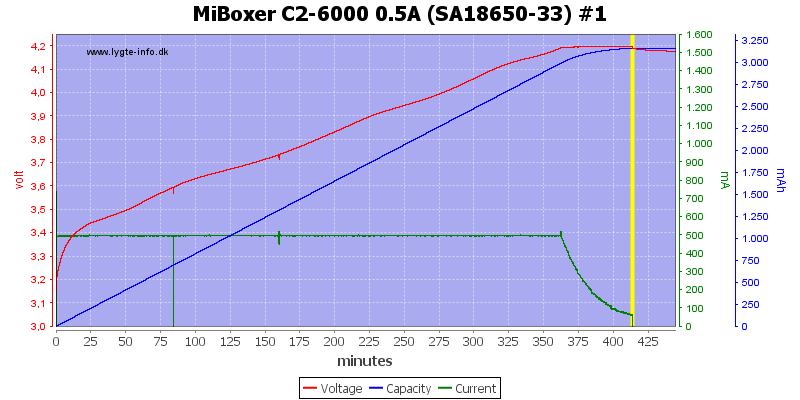
A nice CC/CV charge curve with about 60mA termination current. The ticks on the current line is when the charger checks internal resistance in the battery.
Display shows 6:52 hours 3178mAh 64mOhm
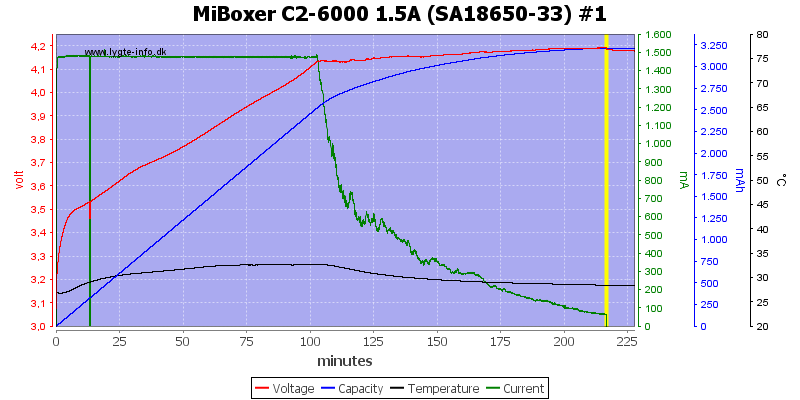
The curve looks just as nice at 1.5A and the battery is charged considerable faster.
Display shows 3:35 hours 3197mAh 94mOhm
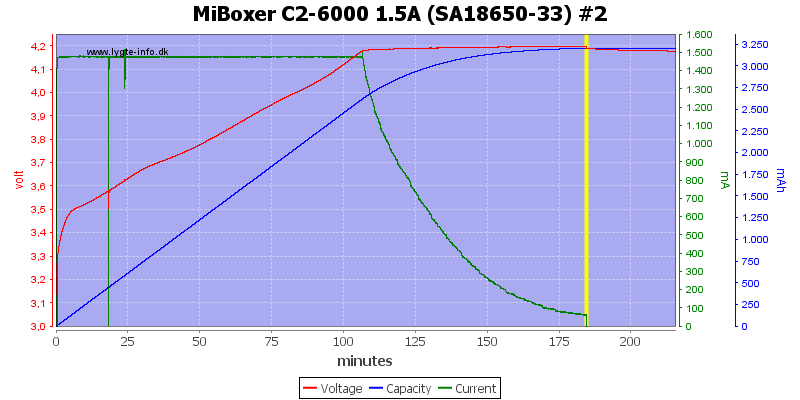
Not much difference to the second slot.
Display shows 3:03 hours 3188mAh 65mOhm
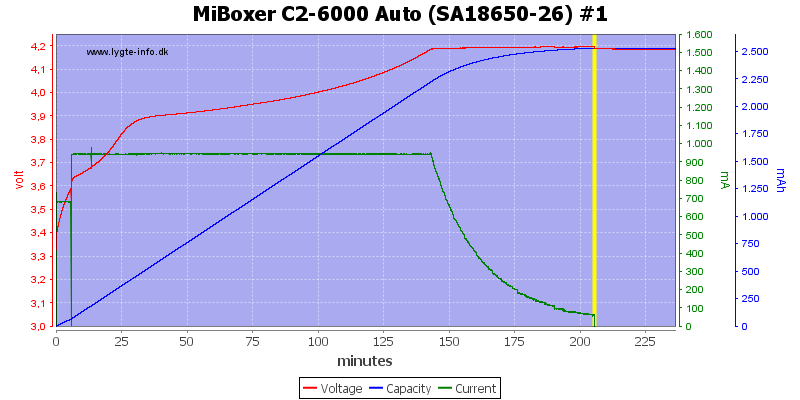
With auto the charger may adjust the charge current each time it checks the internal resistance, here it adjust it once.
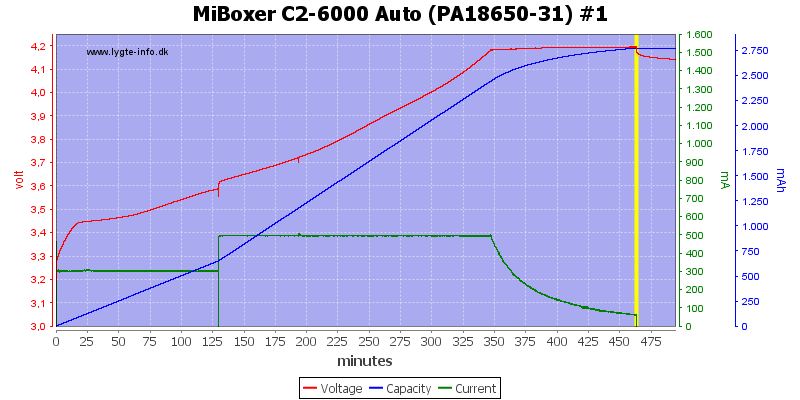
This battery did also get a charge current adjustment.
Display shows 7:42 hours 2789mAh 144mOhm

Even the old battery got an adjustment of charge current, but the current is kept fairly low. The charger has a slight problem with termination, but it do not last for long.
Display shows 13 hours 2286mAh 363mOhm
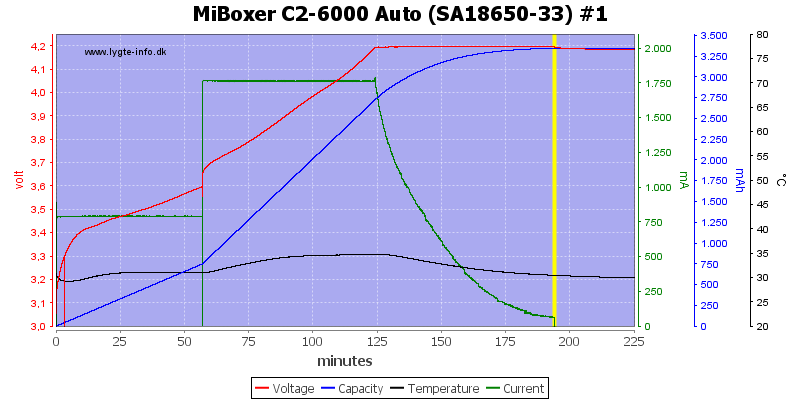
Here the charge current is adjusted to a fairly high value (1.8A) for this cell.
Display shows 3:13 hours 3357mAh 57mOhm
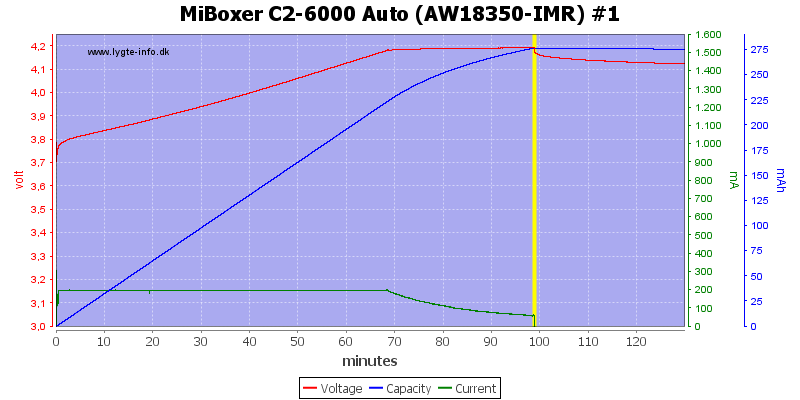
This old worn down cell is handled very nicely by the charger. The low charge current works fine, but I could have wished for a lower termination current.
Display shows 3:38 hours 284mAh 335mOhm
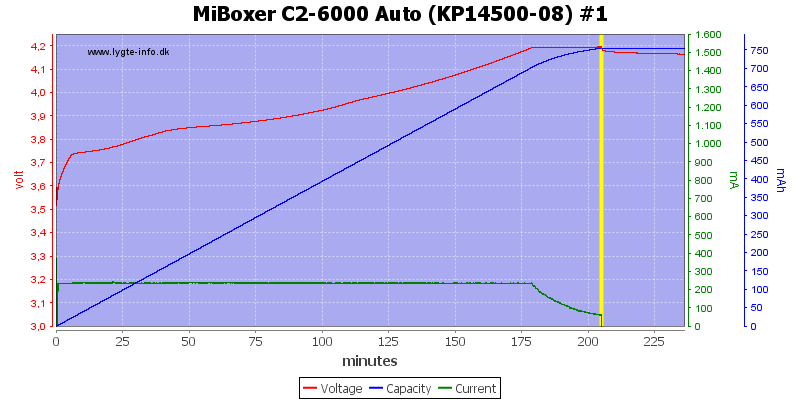
Nicely charged.
Display shows 3:24 hours 793mAh 254mOhm
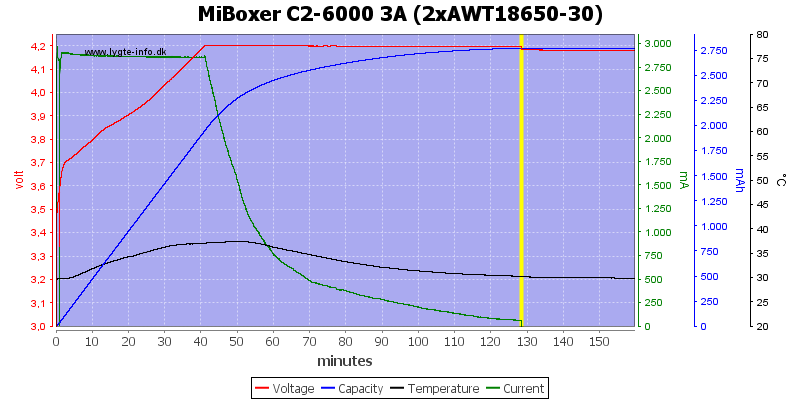
It do not take very long to charge two cells with 3A charge current.
Display shows 2:08 hours 2738mAh 94mOhm and 1:30 hours 2786mAh 70mOhm

To charge at 2x3A it needs about 2.3A from 12V
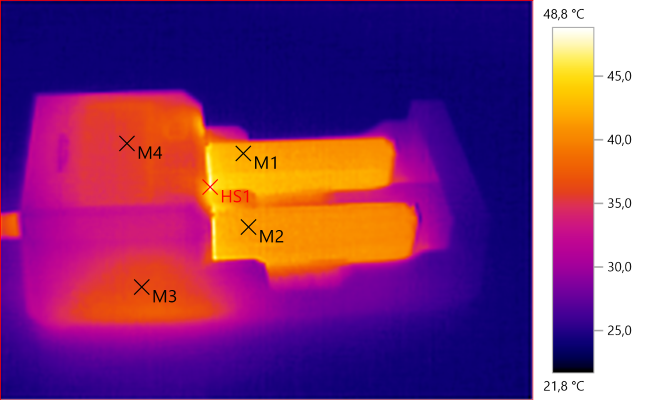
M1: 42,2, M2: 41,5, M3: 36,3, M4: 35,6, HS1: 48,8
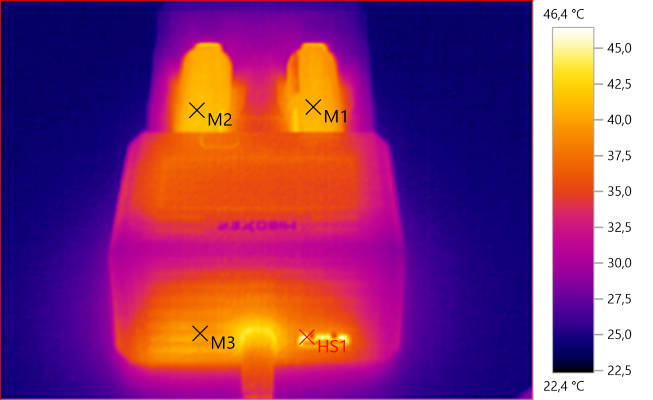
M1: 40,6, M2: 41,3, M3: 39,3, HS1: 46,4
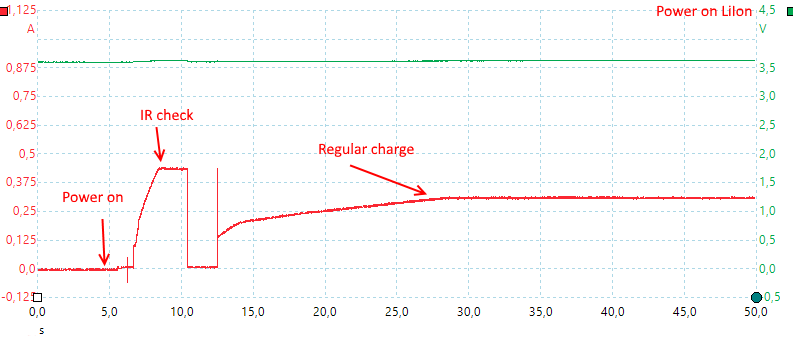


Charging NiMH
Currents: auto, 0.10, 0.20, 0.30, 0.40, 0.50, 0.60, 0.70, 0.80, 0.90, 1.00
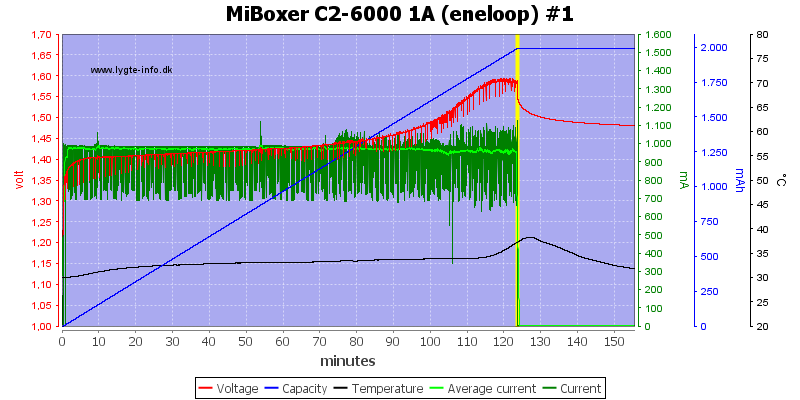
This is a good -dv/dt charge curve, because NiMH is always pulsing it is difficult to see when the charger do a internal resistance check.
Display shows 2:03 hours 1738mAh 236mOhm
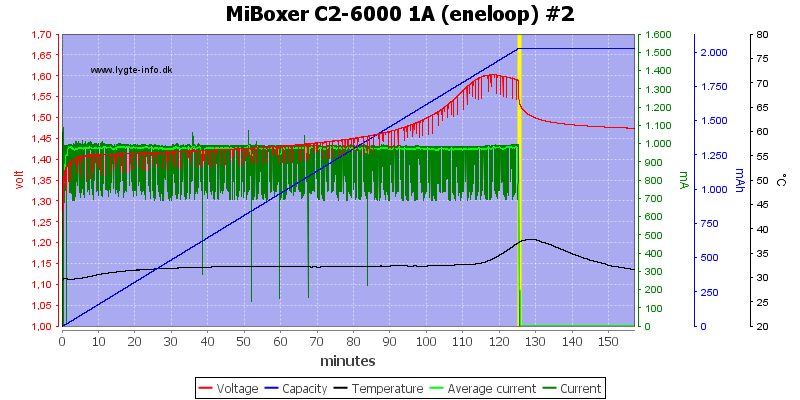
The second slot looks just as nice.
Display shows 2:05 hours 1718mAh 97mOhm
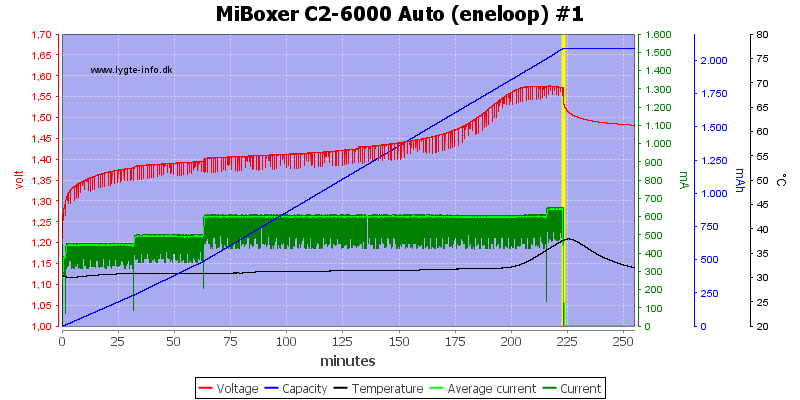
With auto current it is easier to see when the charger do a internal resistance check and adjust the current. The charging looks good, but slower than manual current selection.
Display shows 3:42 hours 1778mAh 63mOhm
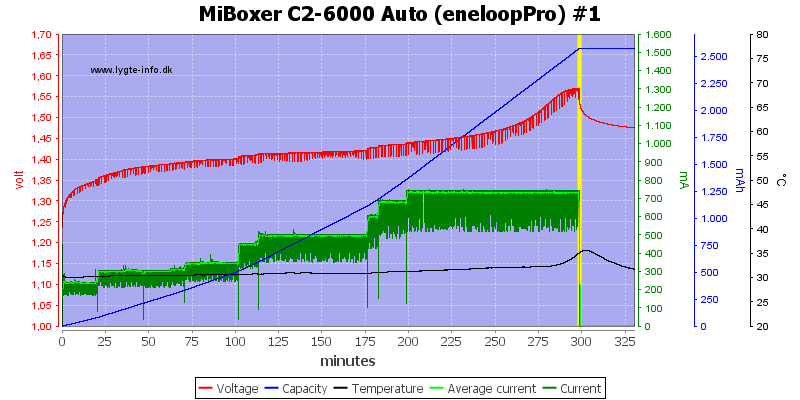
Again a nice charge curve with lot of charge current adjustments.
Display shows 4:57 hours 2221mAh 55mOhm
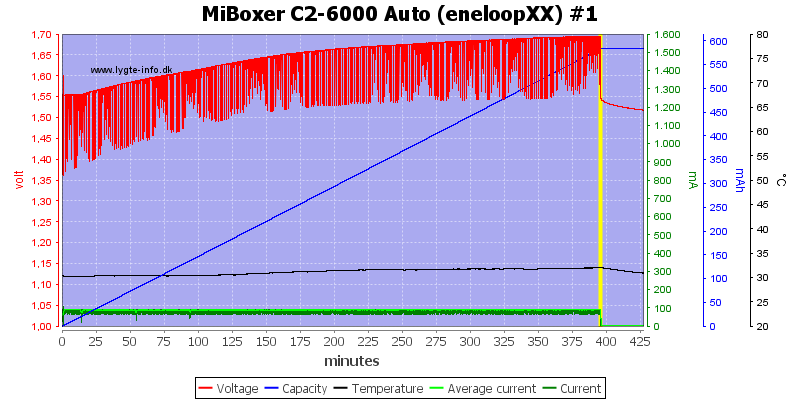
This worn down cell is handled very nicely at a low charge current.
Display shows 1:35 hours 236mAh 999mOhm
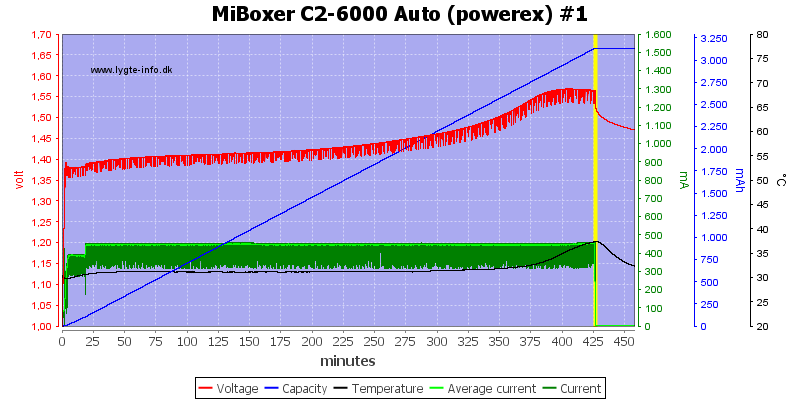
The powerex got a more regular charging with termination when it is full.
Display shows 7:05 hours 2606mAh 99mOhm
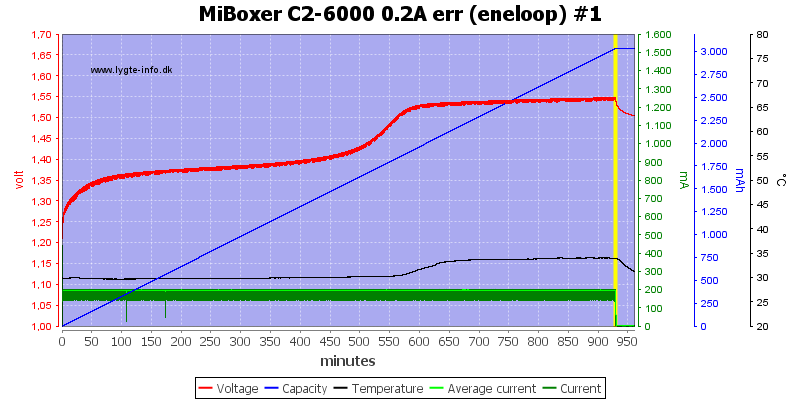
Here I selected a very low charge current for a cell, this means there will not be a -dv/dt signal when the battery is full.
The termination fails and the charger stops with an error after a long time (About 15½ hour).
Using this low charge current can be rated as a user error, but it would be nice if the charger could stop a bit faster (Using 0dv/dt could do that).
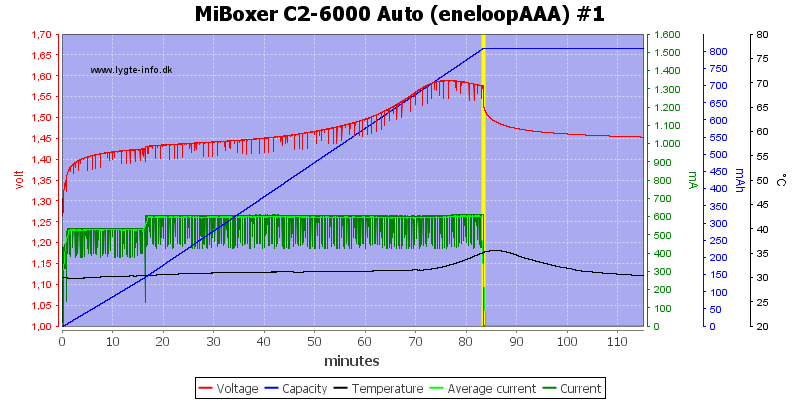
The AAA is charged nicely.
Display shows 1:23 hours 609mAh 75mOhm
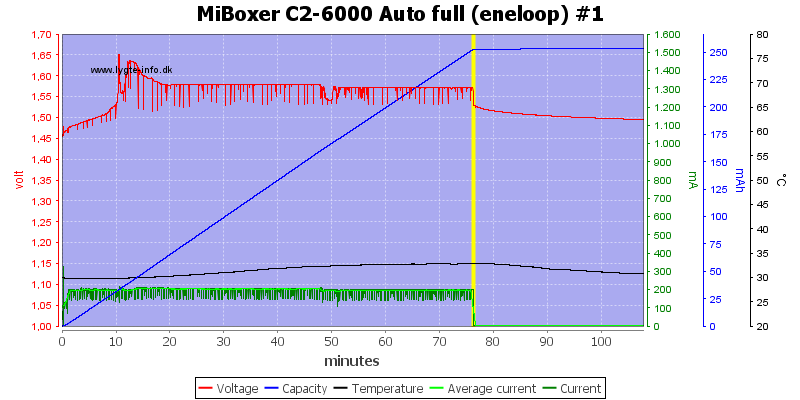
For some reason the charger selected a very low current for this full cell and it took more than an hour before it stopped.
Display shows 1:16 hours 63mAh 205mOhm
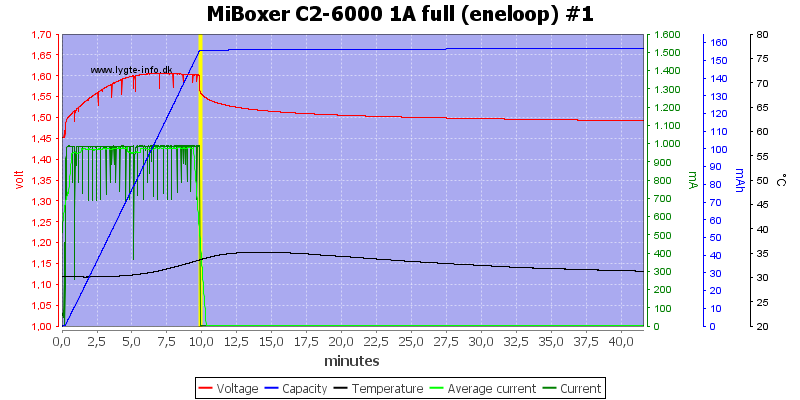
Here I select 1A charge current and the charger detected the full cell in about 10 minutes, that is much more reasonable.
Display shows 0:09 hours 51mAh 81mOhm
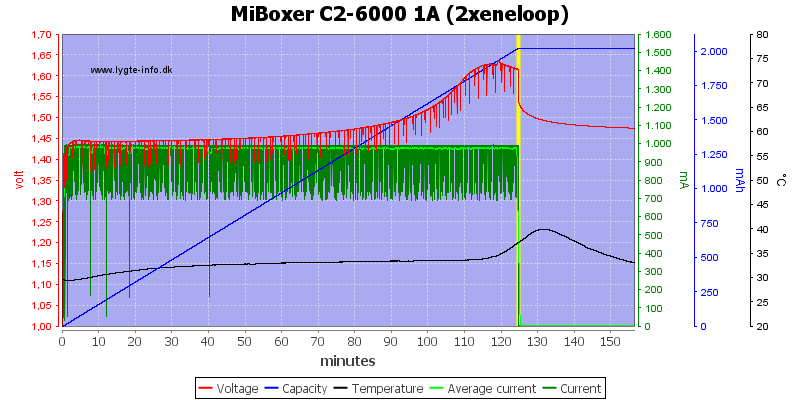
Two batteries at full 1A current is, of course, no problem.
Display shows 2:04 hours 1700mAh 41mOhm and 2:07 hours 1758mAh 36mOhm
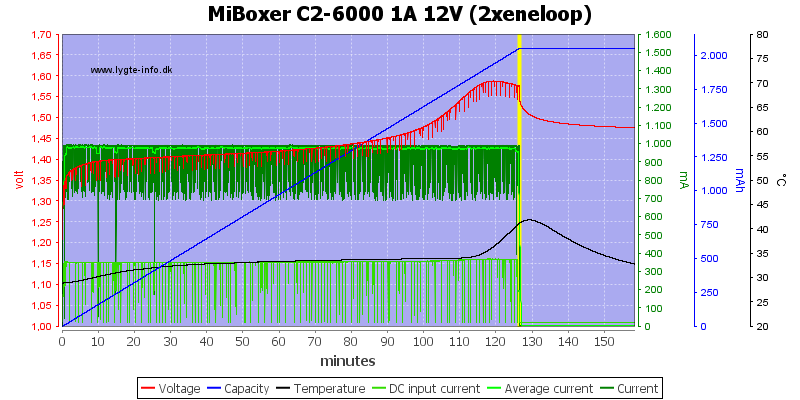
The NiMH charging uses less than 0.4A from 12V
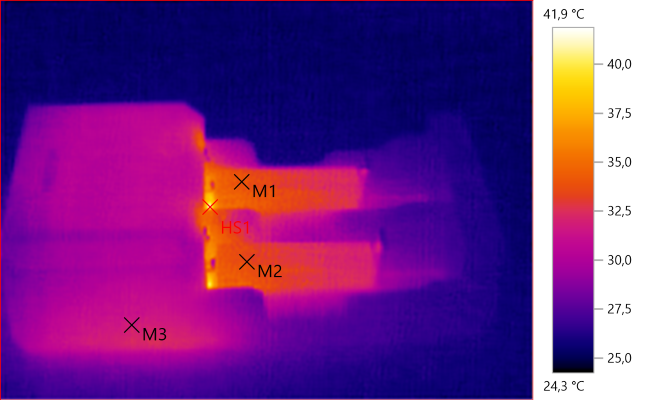
M1: 34,0°C, M2: 33,6°C, M3: 31,7°C, HS1: 41,9°C
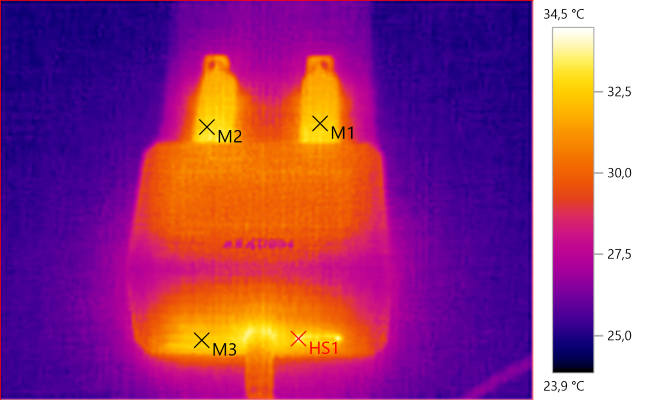
M1: 32,5°C, M2: 33,0°C, M3: 32,4°C, HS1: 34,5°C
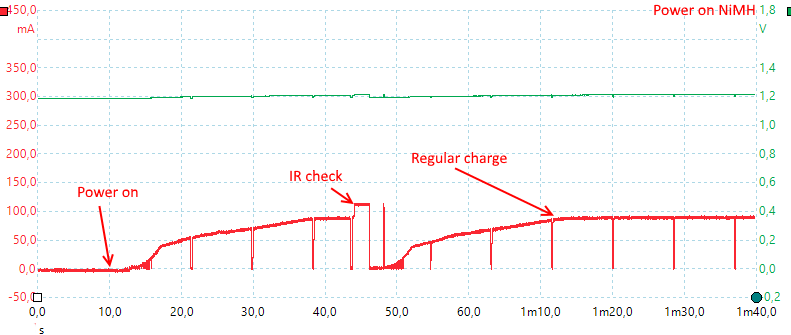
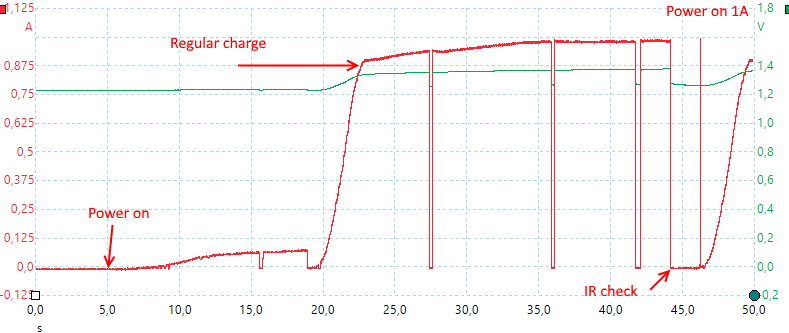
Internal resistance
The charger uses internal resistance to select charge current, this means it has to be fairly good for that to work.
First table is for LiIon:

In the first line I put in the same battery a couple of times, the difference in values is due to the charger or due to changes in contact resistance.
In the other lines I eliminate battery and most contact resistance and only look on the chargers measurements.
As can be seen the charger is good at measuring IR, this means the differences on the first line is most likely due to changes in contact resistance.
And the result for NiMH:

Again the results are good. In slot #1 I had a case of very high contact resistance.
USB output (Power bank)
- Idle current with display on is about 40mA
- Will discharger a LiIon battery with about 0.2mA when not powered.
- An empty LiIon battery will be discharged with about 3mA (bad)
- Usb output is turned on with the yellow button.
- Usb output will turn off when load is below 75mA for 30 seconds.
- On overload the display will show "USb err"
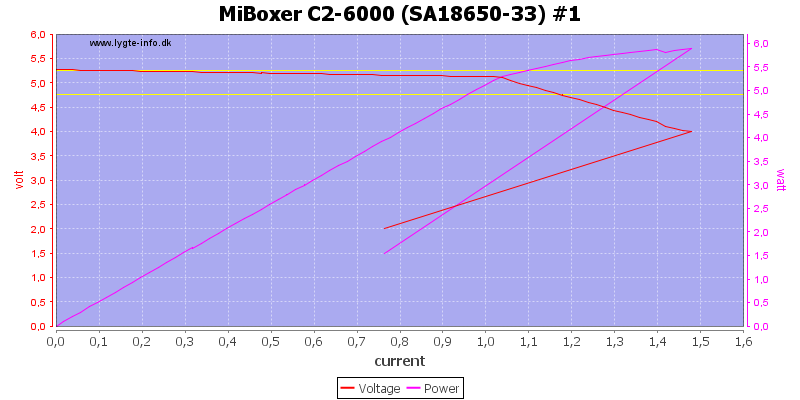
With one battery the charger can deliver 1A on the usb output before the voltage starts to drop.
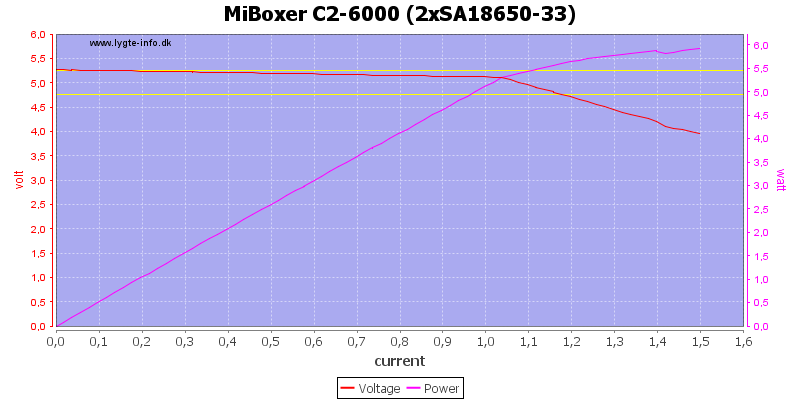
Using two batteries works exactly the same, there is no extra current.
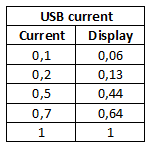
The usb current display is not that precise.

Using a 0.5A load with two batteries works for about 7 hours. The charger only use one battery at a time.
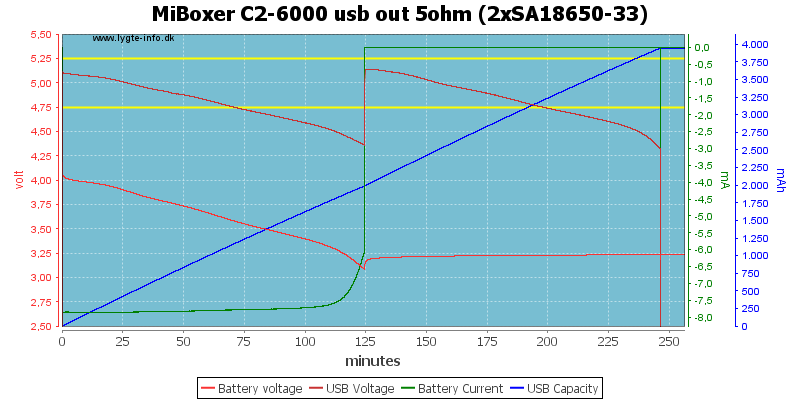
At 1A load it will also first drain one battery, then the other, but the boost converter is not powerful enough to handle 1A with a low battery, output voltage will drop significantly (Below 4.5 volt).

Do not leave empty batteries in the charger, it has a fairly high drain when the battery voltage drops to 3V.

At 0.5A the noise is 42mV rms and 392mVpp.

At 1.0A the noise is 51mV rms and 420mVpp.
Testing the power supply with 2830 volt and 4242 volt between mains and low volt side, did not show any safety problems.
Conclusion
The charger is a good charger for both LiIon and NiMH and the automatic current selection is very nice most of the time.
The disadvantages with the automatic current selection is longer charge time for old/worn cell, it may make the cells last longer, but if you need the batteries fast, it is best to use manual override. The other disadvantage is too high charge current, the will wear the batteries down slightly faster, this can happen with new batteries.
Internal resistance is very precise, as long as you are careful with contact resistance.
The power bank function is not very good, it cannot deliver 1A, if an empty battery is left in the charger it will drain it (a full battery is safe).
The final conclusion is: It is very good for charging both large and small batteries when used with manual current selection, when used in auto I will only call it good.
Notes
The charger was supplied by a Miboxer for review.
Here is an explanation on how I did the above charge curves: How do I test a charger









































































